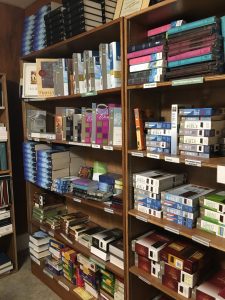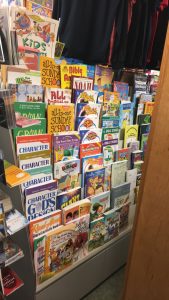
As I connect the floor plan to the owner’s collection in Bible Depot, I can’t seem to think there is a specific reason everything is displayed the way it is. Although the collection is in great abundance of different objects, it’s not hard to tell what this collection represents. It consists of religious books, CD’s, and movies, crosses, urns, jewelry, kids’ toys, and of course, Bibles. Thus, the collection consists of more religious items than anything else. “The critical history of collecting is concerned with what from the material world specific groups and individuals choose to preserve, value, and exchange” (221). The common factor the collection represents is the religious items, so no wonder the name of the store has a religious affiliation to it.
When one sees the outside of Bible Depot, they wouldn’t think the store is very big on the inside. It might not be that big on the outside, but on the inside it looks pretty big because the store is set up and displayed in a way to fit all of their objects in this space. Then, when the person does walk into Bible Depot, they might think, “how do all of the objects fit in the store with the amount of shelves, and bookcases are in this space.” There are so many objects in the store, I wonder how they fit all of it, while still looking presentable. The way the owners of Bible Depot keep everything so organized and not bundled in confusion, is that they have a floor plan and compile all objects in the rooms based on the types of products they sell.

As you can see, there is a lot going on in this floor plan but somehow it makes sense. Each object is particularly placed in a section that makes the most sense to the owner. The card room in the back, consists of mostly cards, with an addition of a DVD library and crosses. The Bible room consists of, yes you guessed it, bibles. It has a place where you can customize your own bible, and it has all different editions of bibles for all different ages in the room. The CD room consists of CD’s, kids’ religious TV shows, and instrumental soundtracks.
The store’s traffic configuration through the bookstore is that when one enters the store they usually veer right and go all the way down that aisle. When I first went to Bible Depot I followed this traffic configuration but when I got to the end of the first room, I didn’t know where to go to next because of the amount of aisles and different doors I could go through; I was a little overwhelmed. But what I find unique about this floor plan is that there are actual doorways one has to go through to get from room to room. To me, this creates an effect that since I left one room and entered another, it’s like a whole new world and I’m going to see something completely different from what I saw in the last room. This effect worked to an extent, because although I felt this when I walked from the room on the right from the entrance, to the CD room, I didn’t feel this way when I walked from the room on the right from the entrance to the room next to the bible room. This is because both rooms have similar book sections.

The books are either kids’ religious bedtime stories/books, or self-help books. I wonder why the books that have two sections in the store are the children books and the self-help books. I guess it’s because they are what the owner values most in the collection. But books aren’t the only objects that the owner values most in the collection because jewelry and urns also have a couple places in the store where they are displayed. According to Clifford, “Religious objects can be valued as great art, as folk art, or as cultural artifact. Such objects have no individual “power” or mystery–qualities one possessed by “fetishes” before they were reclassified in the modern system as primitive art or cultural artifact” (226). It makes sense to me that the religious objects in Bible Depot can be classified as artifacts because there are many crosses, statues, and posters in Bible Depot that seem to be valued and that’s why they are displayed/sold.
Another thing that I found interesting in this floor plan is that the owner lives in the store. It is located in the middle of the bookstore and takes up half of it. When one is in the bible room, card room, and entrance way to the card room they see doors that link to the house. This is interesting to me because even though half the bookstore is taken up by the house, it doesn’t feel like that. It feels like there is so much room because of the amount of items the store contains. The store can also feel like it has a lot of room because of the way the shelves and bookcases are displayed and the amount of items to each shelf and bookcase.
The owner, Nancy Ney, describes the store as “crunchy,” which to me, means that she is able to get all the items and products visible in the store without it being too much of a clutter, too overwhelming, or messy looking. When I first came to the store, I’m not going to lie, I was overwhelmed, but that’s just because I didn’t know what to expect. I thought the store was just going to sell bibles and I really didn’t know what else they were going to have in stock. This might be because I’m not that religious and to me a bookstore should just have books, but an overabundance of books. Bible Depot doesn’t just have books, they have so many other objects that just add to the collection of the store. Thinking about the collection now, it makes sense as to why all the objects Bible Depot sells are being sold. Each object represents something different to the owner and maybe that’s why it’s part of the collection. The book genres don’t vary much, so I feel like if someone were going to go to Bible Depot they’d be looking for the other objects the store has and not the books.
Sources
Text:
Clifford, James. The Predicament of Culture: Twentieth-century Ethnography, Literature, and Art. Cambridge, Mass: Harvard University Press, 1988.
Images:
Courtesy of Michelle Principe


0 Comments